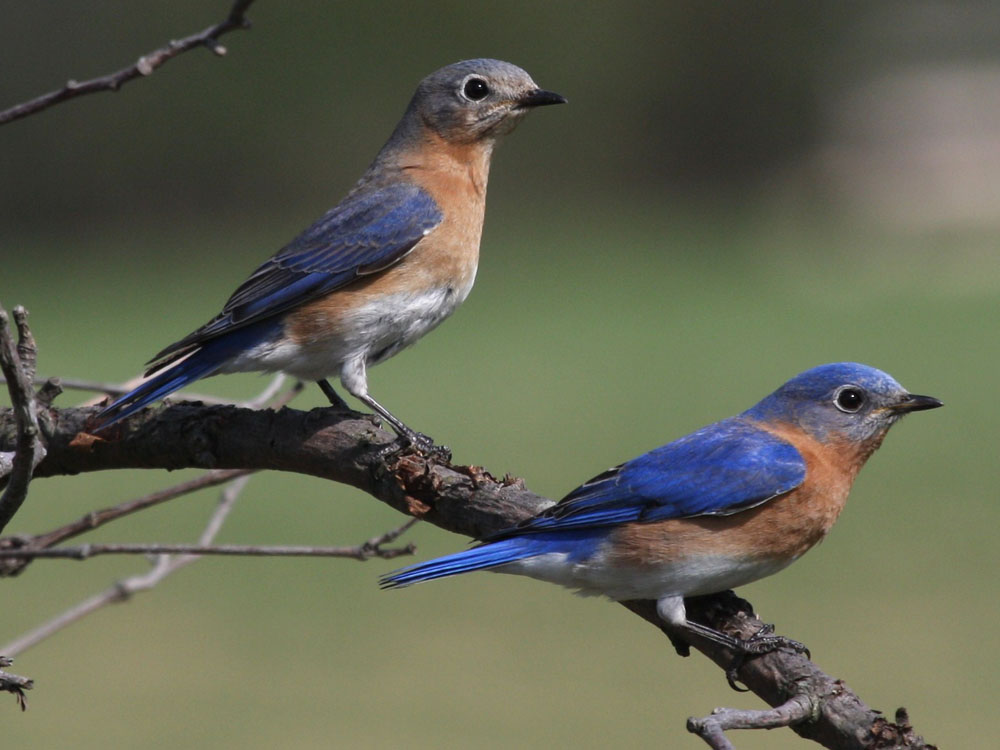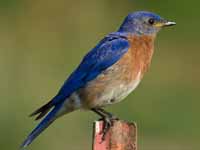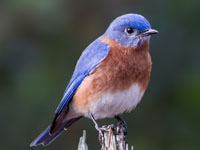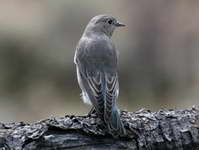THE WORLD BIRDS - An Online Bird Book
TURDIDAE
Order Passeriformes Family Turdidae
Bluebirds
TURDIDAE
Order Passeriformes Family Turdidae
Thrushes are plump, soft-plumaged, small to medium-sized birds, inhabiting wooded areas. Most species are grey or brown in color, often with speckled underparts. Even if the adults do not have these speckles, the juveniles often will. They are insectivorous, but most species also eat worms, snails, and fruit. Thrushes build cup-shaped nests, sometimes lining them with mud. Except for the bluebirds, thrushes construct their nests on branches. The blues place their nests in cavities. Thrushes lay two to five eggs which are usually speckled, sometimes laying two or more clutches per year. Both parents help in raising the young. The songs of some species are considered to be among the most beautiful in the avian world.
The thrushes are presented on the following web pages:
1) Geokichla and Zoothera 2) Bluebirds 3) Solitaires
4) Nigthingale-Thrushes 5) True thrushes (Turdus) 6) Miscellaneous
The thrushes are presented on the following web pages:
1) Geokichla and Zoothera 2) Bluebirds 3) Solitaires
4) Nigthingale-Thrushes 5) True thrushes (Turdus) 6) Miscellaneous
Bluebirds
There are three species of bluebirds: the eastern, mountain, and western; all are in the Sialia genus. They are found in North America and south into Central America. They eat insects, worms, and fruit when insects are scare. Because of their vivid blue color, bluebirds are a favorite of people and their survival is enhanced by feeders and bird houses. Before this intervention, their population had been in decline due to the house sparrow and European startling, both of which are introduced species and compete for nesting spots. Also, the bird houses can be constructed to discourage predators such as snakes, cats, and raccoons. Bluebirds do not like the bird seeds that are commonly put in feeders. However, they can be attacted to platform feeders with grubs that sold by bird supply stores as mealworms. They also like raisons that have been soaked in water.
Genus Sialia
Bluebird, Eastern Sialia sialis
Description: The male eastern bluebird has bright blue upperparts. The throat and breast are reddish-brown and the belly is white. The female has lighter blue, a grey crown, and a whitish throat. The eastern blue bird is up to 21 cm long. The similar western bluebird has little range overlap. The male western bluebird has a blue throat (versus reddish-brown throat) and the female has a grey throat (vs an off-white throat).
Range: East of the Rocky Mountains of North America, Central America
Habitat: Open country, but near trees.
Diet: Mainly insects and other invertebrates; also fruits, berries, worms, centipedes. Some native pecan trees commonly produce nuts that house worms. This is not good from a human perspective, but bluebirds appreication when the the worms exit the nuts.
Conservation status: Least Concern.
Image by: 1) Putneypics - Vermont 2) SandyPhotos2009 - Michigan 3, 4) Dick Daniels - North Carolina 5) Ken Thomas - North Carolina 6) Andy_Morffew Range: East of the Rocky Mountains of North America, Central America
Habitat: Open country, but near trees.
Diet: Mainly insects and other invertebrates; also fruits, berries, worms, centipedes. Some native pecan trees commonly produce nuts that house worms. This is not good from a human perspective, but bluebirds appreication when the the worms exit the nuts.
Conservation status: Least Concern.
1) Eggs & nest 2) Pair 3, 4) Female 5, 6) Male






Bluebird, Mountain Sialia currucoides west North America
Description: The male mountain bluebird has mainly bright turquoise-blue plumage, somewhat lighter underparts, and an even lighter lower-belly. It has black eyes and a thin black bill. The female has a grey back, crown, and throat. The wings and tail are dull blue. The male mountain bluebird is up to 18 cm long.
Range: Western North America from Mexico to Alaska. They migrate from the northern range to the southern in the winter.
Habitat: Open country including mountainous terrain.
Diet: Mainly insects in the summer and berries in the winter. Also worms.
Conservation status: Least Concern.
Image by: 1) Alan D. Wilson - British Columbia 2) Linda Tanner 3) Dick Daniels - Wyoming 4) Elaine Wilson - Oregon 5) Mathew Paulson - South Dakota 6) Jerry Oldenettel - New Mexico Range: Western North America from Mexico to Alaska. They migrate from the northern range to the southern in the winter.
Habitat: Open country including mountainous terrain.
Diet: Mainly insects in the summer and berries in the winter. Also worms.
Conservation status: Least Concern.
1 - 3) Female 4 - 6) Male






Bluebird, Western Sialia mexicana Found: west North America
Description: The male western bluebird has bright blue upperparts and throat. There is usually a brown patch on the back. It has an orange breast and flanks. The belly is grey as are the under-tail coverts. The female is duller. She has a grey throat and dull orange breast. The western bluebird is up to 18 cm long, about the same size as the mountain bluebird.
Range: Pacific Northwest, and British Columbia to northen Mexico.
Habitat: Forests, farmlands, and even deserts.
Diet: Mainly insects and berries; also worms, From a perch that can fly to catch insects in air.
Conservation status: Least Concern.
Image by: 1) Sarah Stierch - California 2) David Hofmann - California 3, 4) Alan D Wilson - Oregon Range: Pacific Northwest, and British Columbia to northen Mexico.
Habitat: Forests, farmlands, and even deserts.
Diet: Mainly insects and berries; also worms, From a perch that can fly to catch insects in air.
Conservation status: Least Concern.
1, 2) Female 3, 4) Male




